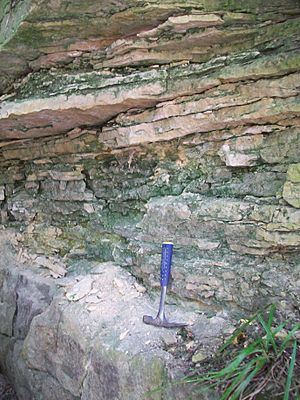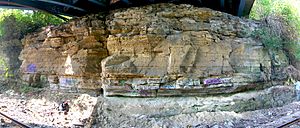Jordan Formation facts for kids
Quick facts for kids Jordan FormationStratigraphic range: Late Cambrian |
|
|---|---|

Outcrop of the Jordan Sandstone at Hoyt Park, Madison, WI. The rock-hammer rests near the contact of the Van Oser Member and overlying Sunset Point Member.
|
|
| Type | Geological formation |
| Unit of | Trempealeau Group |
| Sub-units | Norwalk Member, Van Oser Member, Waukon Member, Sunset Point Member |
| Underlies | Oneota Formation of the Prairie du Chien Group |
| Overlies | St. Lawrence Formation of the Trempeleau Group |
| Thickness | 15–115 m (49–377 ft) |
| Lithology | |
| Primary | sandstone |
| Location | |
| Region | Iowa Shelf, Wisconsin Arch, Lincoln Anticline, Michigan Basin |
| Country | United States |
| Extent | Minnesota, Wisconsin, Illinois, Michigan, Iowa, Missouri |
| Type section | |
| Named for | Jordan, Minnesota |
| Named by | N. H. Winchell (1874) |
The Jordan Formation is a type of sandstone rock found in the central United States. You can find it in states like Illinois, Michigan, Wisconsin, Minnesota, and Iowa. It is also known as the Jordan Sandstone.
This rock unit got its name from special rock outcrops near the town of Jordan, Minnesota. It stretches across a large area, including the Iowa Shelf and into the Michigan Basin.
The Jordan Formation is the top layer of rocks from the Cambrian Period in North America. It is mostly made of quartz sand, which is like very pure sand. This sand is not strongly glued together.
The Jordan Formation is very important because it is a source of silica. In the past, people mined this rock to make glass. More recently, it has been used for "frac sand" in the oil and gas industry. Because it is porous and not well-cemented, it also holds a lot of water. This makes it a major source of drinking water for many people in the upper Midwest.
Contents
What is the Jordan Formation?
Scientists first noticed the rocks of the Jordan Formation a long time ago. In 1852, a scientist named D. D. Owen wrote about it. He called it part of his "Lower Sandstone."
Later, in 1874, N. H. Winchell gave it the name "Jordan Sandstone." He described it based on rocks he saw in a quarry near Jordan, Minnesota.
Where is the Jordan Formation found?
You can see the Jordan Formation in many places. It forms rock outcrops in Wisconsin, Minnesota, and Iowa. It is especially visible along the Mississippi River and its smaller rivers.
This rock unit is also hidden underground in these states. Scientists have found it by drilling into the earth in Illinois, Missouri, and Michigan. In these states, it is not found at the surface.
Similar rocks from the same time period exist in other areas. However, they have different names. For example, the Eminence Dolostone in Illinois and the Au Train Formation in Michigan are similar.
What is the Jordan Formation made of?
The Jordan Formation is mostly made of very pure, well-sorted sandstones. This means the sand grains are all about the same size and shape. Most of it is quartz, but it also has other minerals like feldspar. You can also find tiny pieces of ancient sea creatures in it.
Scientists have found at least three main types of rock within the Jordan Formation. These types are different based on how the sand grains are arranged and their size.
- One type has wavy layers, called hummocky cross-stratified.
- Another has curved layers, called trough-cross stratified.
- A third has very large, angled layers.
Overall, the Jordan Formation gets coarser (sand grains get bigger) as you go higher up in the rock layers.
How does the Jordan Formation fit with other rocks?
The Jordan Sandstone is usually considered the top part of the Trempealeau Group of rocks. Its thickness can range from about 15 to 115 meters (50 to 377 feet).
Rocks below the Jordan Formation
The lower part of the Jordan Formation has more feldspar minerals. It gradually blends into the rock unit below it. In most of the upper Midwest, the Jordan Formation sits on top of the St. Lawrence Formation.
The St. Lawrence Formation has two main parts:
- A dolomite rock part called the Black Earth Member.
- A silty rock part called the Lodi Member.
Older studies sometimes grouped the Jordan and St. Lawrence formations together. However, scientists can tell them apart by looking at the types of rock. The bottom of the Jordan Formation is usually found right above the top siltstone layer of the Lodi Member.
Rocks above the Jordan Formation

The Jordan Formation is covered by the Oneota Formation. The Oneota Formation is a type of rock called dolomitic carbonate. It formed during the early Ordovician Period.
The Oneota Formation is made of thick, strong layers of rock. These layers usually sit on top of several meters of sandy shale. This sandy shale is sometimes called the Coon Valley or Stockton Hill Member. Even though these sandy layers were once thought to be part of the Jordan Formation, newer studies suggest they are more closely related to the Oneota.
The top surface of the Jordan Formation is uneven. This suggests that there was a period of time when erosion happened before the Oneota Formation was laid down.
Parts of the Jordan Formation
The Jordan Formation has at least four named parts, or subunits. These parts are different based on their rock structures, grain size, and where they are found in the rock layers.
- The bottom part is the Norwalk Member. It is made of fine-grained sandstone with wavy layers. It has a lot of feldspar. This part also shows signs of ancient marine organisms burrowing through it. Sometimes, you can find fossils here.
- The Norwalk Member is usually covered by the Van Oser Member. This part is a medium-grained quartz sandstone with curved layers. There are at least two layers of this type of rock within the Jordan Formation.
- These Van Oser layers are often separated by other types of sandstone. One is a fine-grained, wavy-layered sandstone called the Waukon Member.
- Another is a laminated (thinly layered) feldspathic quartz sandstone with dolomite cement. This part is called the Sunset Point Member.
How did the Jordan Formation form?
How it was deposited
Scientists believe the Jordan Formation formed in ancient marine (ocean) environments. This is because they have found rare fossils and signs of ancient creatures burrowing in the sediments.
The fine-grained parts of the rock, where creatures burrowed, likely formed in shallow ocean areas. These areas were affected by tides and storms. The coarser, cross-bedded parts, like the Van Oser, might have formed from large sand dunes under the sea.
The Jordan Formation is one of many "sheet sandstones." These are wide, thin layers of sandstone that covered a large part of the North American continent during the late Cambrian Period. At that time, most of North America was covered by a shallow sea. This sea was blanketed by continuous sheets of sand and other rocks.
How old is the Jordan Formation?
The Jordan Formation has long been known to be from the Upper Cambrian Period. Scientists know this because of fossils of creatures called trilobites found in the rock. For example, the presence of trilobites like Tellerina strigosa helps determine its age.
Tiny tooth-like fossils called conodonts found in the Norwalk Member also confirm its age. They suggest it belongs to the Eoconodontus zone.
The rock unit above the Jordan, the Oneota Formation, is from the early Ordovician Period. This means the boundary between the Cambrian and Ordovician periods is either in the very top of the Jordan Formation or right where it meets the Oneota. Scientists are still studying this exact boundary.
Why is the Jordan Formation important today?
Frac sand
The sand from the Jordan Formation is very useful. It is well-sorted and has rounded grains. This makes it perfect for use as a "proppant" in hydraulic fracturing, also known as fracking.
In fracking, this sand is added to liquids pumped into the ground. It helps to keep tiny cracks in the rock open. This allows oil and gas to flow out. The Jordan Formation is thick, not very hard, and close to rivers and roads. This makes it a good target for mining companies.
Drinking water
The Jordan Formation is made of coarse sand and is not strongly cemented. It also has very little clay. These features mean that water can easily flow through it.
Because of this, the Jordan Formation is an excellent aquifer. An aquifer is an underground layer of rock that holds groundwater. This aquifer provides a major source of drinking water for many people across the north-central United States.


